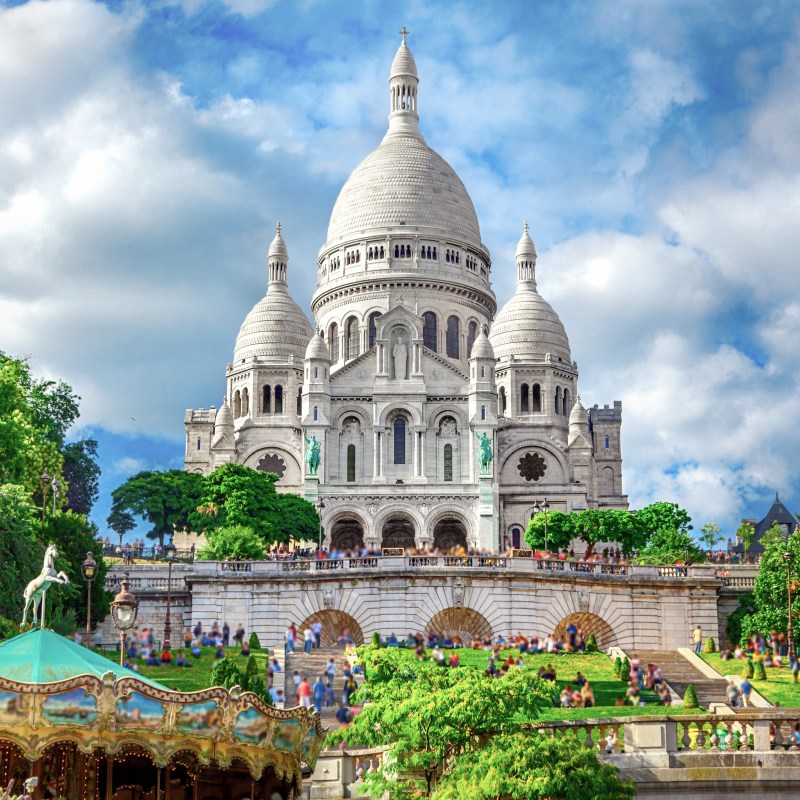
I discovered Montmartre on my first trip to Paris in the late 1970s and fell in love with the quaint beauty of it, but on my subsequent trips to Paris, somehow, I never returned. I moved to Paris in 2005, and in 2007, when I started to give private tours of the city, I received a number of requests from clients for a Montmartre tour. I went back to Montmartre to delve more into the sites and the history before I gave my tours, and I was smitten once again, and even more so than when I first visited. Not only did I reconnect with the sites I knew, but I also discovered a bounty of places I hadn’t seen before.
Videos by TravelAwaits
Here’s a list of essential things to do and see in my favorite neighborhood of Paris, Montmartre.

1. The History Of Montmartre
The history of Montmartre goes as far back as the 3rd century, when Paris was settled by the Romans. The legend for how Montmartre got its name, which means “mountain of the martyr” in Latin, goes that there was a bishop named Denis who lived in Paris in the 3rd century, and he and two other saints were decapitated for their sins. After his head fell to the ground, Saint Denis picked it up, cradled in his arms, and walked several miles north of Paris, still preaching his sermon, until he reached a high mount.
In 1134, the Saint-Pierre de Montmartre was constructed. The Royal Abbey of Montmartre was, as well, which contained a Benedictine monastery. In the 1500s, thirteen windmills were installed to grind different types of grain, and today all but two of them still exist.
The two sites took up most of the land of Montmartre and existed until 1790, when the French Revolution had the convent destroyed to make room for gypsum mines, which produced the material used for plaster.
Technically, Montmartre was a separate village just north of Paris, and not incorporated into the city, until 1860. Perhaps this is why it still feels like a country village, and different from most other neighborhoods of Paris.
In the late 1800s and early 1900s, Montmartre was a haven for artists, and many of our now most famous artists, such as Renoir, Degas, Toulouse-Lautrec, Van Gogh, and Picasso, lived here and painted their masterpieces.

2. Sacre-Coeur Basilica
The most popular attraction in Montmartre is the Sacre-Coeur Basilica, which is 427 feet above Paris (and appears in our list of incredible Parisian churches to visit that aren’t Notre Dame). Although the Roman-Byzantine style of architecture of Sacre-Coeur, with its creamy, white travertine stone towers, looks centuries old, it’s actually a 20th-century basilica. In 1871, Paris was ravaged by two lost wars, the Franco-Prussian War and the 1870-71 Paris Commune uprising. Sacre-Coeur was built to honor the soldiers who died in the Franco-Prussian War and to uplift the morale of the people of the city.
Work began in 1871 and the basilica was set to open in 1914, but because of the interruption of WWI, Sacre Coeur was not consecrated until 1918. The highlight of the inside of Sacre-Coeur is the massive mosaic (one of the largest in the world) above the altar, entitled Christ in Majesty, which depicts Christ in white robes with his arms reaching out and displaying a golden heart. There’s also a 225-foot dome surrounded by angels, and if you have the stamina, you can climb up to the top of it and walk around the sides. Mass is held at least three times a day at Sacre-Coeur, and extra times are added on holidays.
Pro Tip: If you don’t want to climb up 222 stone steps up to Sacre-Coeur, take the funicular up the steep hill. When you are in front of the basilica, turn around and view the majestic panorama of Paris below you.

3. Place Du Tertre
Just around the corner from Sacre-Coeur is the delightful Place du Tertre square, where the spirit of the artist colony of yesteryear is still alive today with 140 artists painting portraits and landscapes right on the spot. You can purchase an original watercolor of Paris for as little as $25 or a large-scale oil painting for over $1,000. You can also have your portrait done in as little as 20 minutes. A number of lively outdoor cafes surround the Place du Tertre. Here, you can enjoy a drink or snack and also to watch the painters in action.
Pro Tip: You can haggle the price a little bit, say 10 or 15 percent, but don’t expect any more, unless you buy more than one work from the same artist.

4. Rue De L’Abreuvoir
Named one of the most beautiful streets in Paris, Rue de l’Abreuvoir is a winding street that’s lined with ivy-covered free-standing houses from the late 1800s — a rarity in Paris, since most of the city is made up of apartment buildings. At the foot of the street is the adorable La Maison Rose (The Pink House), a restaurant and cafe since 1905 that was recently shown in the hit TV series Emily in Paris. At the other end of Rue de l’Abreuvoir is Place Dalida, a tree-lined square with a bronze statue of the French singing sensation Dalida, who sold more than 170 million records worldwide during a career spanning from the 1950s to the mid-1980s.

5. Museum Of Montmartre
Get an authentic sense of what it was like to live in Montmartre at the turn of the 20th century at the Museum of Montmartre. The complex of buildings was once the home and studio of painter Pierre-Auguste Renoir; later, it was home to one of the only recognized female artists of her time, Suzanne Valadon. The rich history of Montmartre at the turn of the 20th century is told through a series of posters, artifacts, drawings, and paintings, and the creative community of the time, including poets, writers, performers, dancers, painters, and musicians. The complex also boasts a lovely garden.

6. Cabaret Au Lapin Agile
Once the haunt of struggling artists and writers living in Montmartre in the 19th century, including Renoir, Apollinaire, Modigliani, and Utrillo, Cabaret Au Lapin Agile is still an operation and continues to put on nightly shows. It is said that Picasso was so poor as a young man that he asked the owner of Lapin Agile if he could trade one of his early figurative paintings for food and drink.

7. Avenue Junot And Villa Leandre
Avenue Junot is one of the most prestigious streets of Montmartre and is lined with former private mansions in the Art Deco style and apartment buildings in the ornate Art Nouveau style. This quiet residential street with little car or foot traffic is just a few blocks from the more touristy area of Montmartre. Villa Leandre is a cul-de-sac just off of Avenue Junot and has a row of unique, cottage-type houses built in 1926.

8. Montmartre Cemetery
Although it’s not as well-known as the Pere Lachaise Cemetery, the Montmartre Cemetery is just as fascinating. Opened in 1825 on the site of an abandoned gypsum mine, the cemetery was built because the other cemeteries of Paris were running out of room.
Montmartre Cemetery has an abundance of tombstones and mausoleums of well-known residents of Paris, including designer Pierre Cardin, singer Dalida, artist Edgar Degas, writer Alexandre Dumas, American singer Carole Fredericks, actress Jeanne Moreau, and writer Emile Zola.

9. Restaurants, Cafes, And Food Shops
For the best roast chicken in Paris, head to Le Coq Rico, a restaurant specializing in poultry. The juicy chickens are roasted on a state-of-the-art rotisserie and served with a side of creamy macaroni and cheese and house-made fries.
Located underneath one of the last existing windmills in Montmartre, Le Moulin de la Galette serves classic French cuisine in a romantic atmosphere. Their three-course lunch menu at 26.50€ is an excellent value.
Savor the number one baguette in Paris at Le Grenier a Pain, a bakery that has won the coveted prize twice.
A jaw-dropping view of Paris awaits you at the Terrass” Hotel’s restaurant and bar, which serves lunch, dinner, and drinks.
Pro Tips
Montmartre is quite hilly, and many of the streets have cobblestones, so wear rubber-soled shoes or sneakers.
While you’re in the City of Light, consider:
